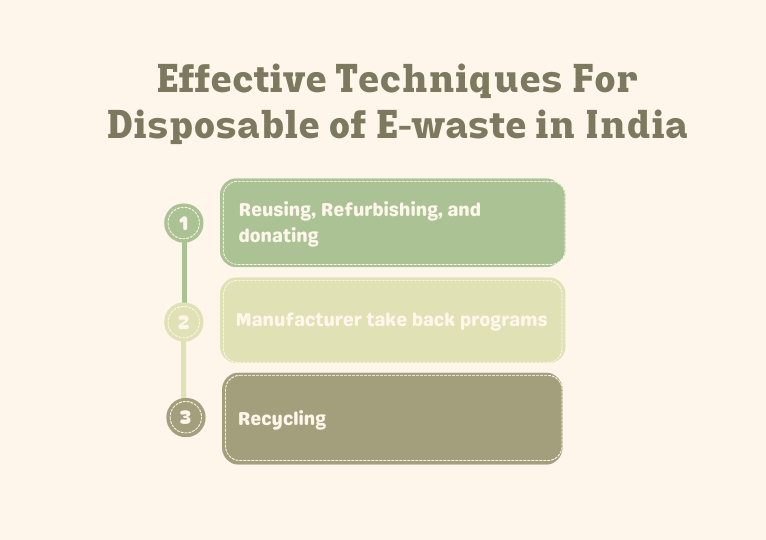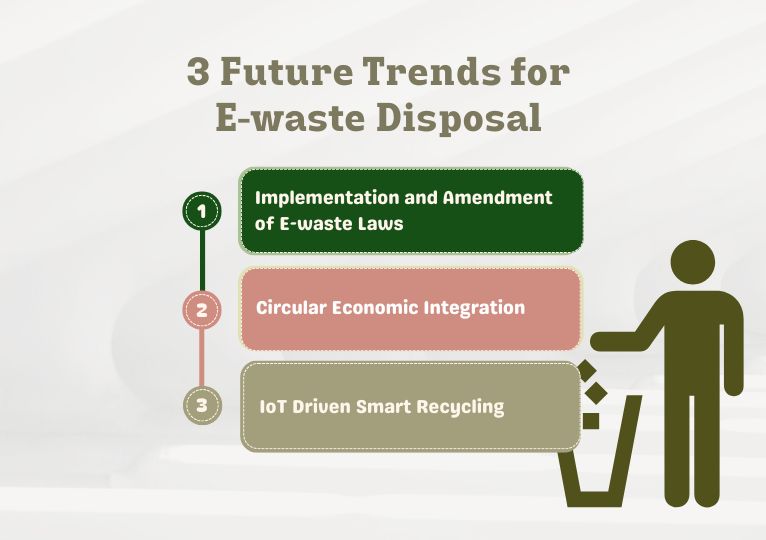3 Most Effective Techniques for Disposal of E-Waste
Disposal of e-waste is all about following best practices and techniques. This may involve proactively choosing eco-friendly recycling methods, ensuring secure data destruction, and complying with environmental regulations.
As an individual or business, it is crucial to be aware of the alarming issue of e-waste. Statista reveals that there’s been a twofold jump in e-waste disposal rates since 2010. That’s an explosive growth. That’s equivalent to discarding 1000 laptops per second.
The scale of this issue is overwhelming and the consequences are devastating. Each of our electronic devices thrown away carries the potential to damage our future. Hence, now is the time to adopt responsible practices for the disposal of e-waste. In this blog, we’ll walk you through some of the best ways to dispose of e-waste.
Table of Contents
- What is E-Waste or WEEE?
- Why is the Disposal of E-Waste Crucial?
- Effective Techniques for Disposal of E-Waste in India: How to Dispose E Waste?
- Manufacturer Take-Back Programs
- Recycling with Certified Partners
- Reusing, Refurbishing, and Donating
- When to Dispose vs. When to Repair
- Securing Data During Disposal of E-Waste
- How Can USH India Recyclers Help You?
- 3 Future Trends in Disposal of E-Waste You Must Know In 2025
- How Apple Uses Robots to Recycle Electronics in a Sustainable Way
- Methods of Disposal of E-Waste at a Glance
- FAQs
What is E-Waste or WEEE?
E-waste includes a broad variety of items. From smaller consumer electronics such as smartphones, tablets, and chargers to larger appliances like microwaves, flat-panel TVs, and washing machines. E-waste is also often known as WEEE (Waste Electrical and Electronic Equipment).
Why is the Disposal of E-Waste or WEEE Crucial?
Improper handling of electronic waste poses serious health risks, including birth defects, damage to the nervous system, and organ failure. That’s the most important reason for the effective disposal of e-waste.
Other than that, toxic elements of e-waste like lead and cadmium, contaminate the environment. So, it is essential to curb the pollution of air, waste, and soil.
Additionally, there are many precious metals present in e-waste like gold, palladium, silver, and more. Sources claim that a single tonne of e-waste can contain up to 800 times more gold than gold ore. Hence, proper recycling and disposal of e-waste is an economical solution too.
Effective Techniques for Disposal of E-Waste in India: How to Dispose E Waste?
1. Manufacturer Take-Back Programs
Many electronics companies now offer take-back services to dispose of e-waste responsibly. We as consumers need to send or drop off obsolete electronic items to the manufacturer. The brand may share positive feedback in the form of a discount or gift card.
Leading electronics company, LG Electronics picks up their products at no cost, including refrigerators, TVs, and ACs.
2. Recycling
Recycling is one of the most sustainable methods for e-waste disposal, as it involves safely recovering valuable materials and managing hazardous components. It’s always better to look for a certified e-waste recycling partner. They follow best practices for data security and compliance. Research their certifications, testimonials and finally opt for a suitable one.
3. Reusing, Refurbishing, and Donating
Reusing or refurbishing electronics is an eco-friendly way to reduce e-waste. Refurbished products are inspected for functionality, and hence save you any unwanted costs. They also reduce toxic landfill waste. Donating functional gadgets to charities is also a great step toward promoting digital inclusion. Moreover, it supports your organization’s CSR initiative. The best part is obviously saving the environment.

When to Dispose vs. When to Repair
The choice between disposal and repair depends on several factors. Repair makes sense if the cost to fix the device is nowhere near its potential performance boost.
Recycling becomes the better option if:
- The repair costs exceed the device's value
- Components are soldered directly into hardware
- The device is outdated beyond practical use
Securing Data During Disposal of E-Waste
Data protection during e-waste disposal is as significant as the disposal itself. Surveys confirm information loss is a leading cause of worry among most IT leaders.
a. Data Wiping Best Practices
Standard file deletion or factory reset won't permanently remove your data. Specialized data erasure software that overwrites existing information multiple times will give better results. Below are the NIST methods that work best:
- NIST Clear: Uses standard commands to rewrite data
- NIST Purge: Combines overwriting with cryptographic erasure
- NIST Destroy: Implements physical destruction methods
b. Physical Destruction Methods
Physical destruction provides a definitive solution for highly sensitive data. This table shows the main destruction methods and their effectiveness:
- Shredding: Ideal for hard drives; breaks them into 2mm pieces for secure data destruction.
- Degaussing: Best for magnetic media; disrupts the magnetic field to erase data completely.
- Crushing: Suitable for all devices; ensures complete physical destruction of hardware for effective disposal.
How Can USH India Recyclers Help You?
USH India Recyclers is a top E-Waste Recycling Management Company in India with more than 10 years of experience. We offer secure solutions like data destruction, hard drive shredding, IT liquidation, and IT asset disposal. We serve small, medium, and large-sized enterprises.
As CPCB-authorized recyclers, we are committed to maintaining the highest standards of safety and quality. Our certifications, OHSAS 18001 and ISO 45001, underscore our dedication to occupational health, and environmental responsibility. Connect with us now!
Learn More About The Best Recycling Services In Mumbai and Request A Pickup!
3 Future Trends in Disposal of E-Waste You Must Know In 2025
Explore the latest technologies that will be changing the narrative of e-waste disposal in India. They are:
- Implementation and Amendments of E-Waste Laws: India’s E-Waste (Management) Rules framework was laid out in 2022 and became effective in 2023. Amendments have been made after its execution. The recent most amendment was made in 2024. Similar efforts are being made by governments worldwide to enhance their e-waste management.
- Circular Economy Integration: The transition to a circular economy for electronics is critical as global digital consumption grows. E-waste and ICT-related emissions are on the rise. Governments, citizens and industries face challenges due to limited recycling, repair, and remanufacturing efforts.
- IoT-Driven Smart Recycling: IoT-enabled smart bins automate e-waste collection and sorting, guiding users on proper disposal. Recycling facilities leverage IoT for predictive maintenance and efficient tracking of environmental impacts.

How Apple Uses Robots to Recycle Electronics in a Sustainable Way
Apple has been pioneering e-waste management with robotic technology, namely Daisy and Liam. They efficiently dismantle multiple iPhone models for recycling, reducing e-waste, and promoting resource recovery.
Methods of Disposal of E-Waste at a Glance
Moving forward, the e-waste challenge demands a comprehensive approach. Knowing the best techniques for the disposal of e-waste helps. By participating in take-back programs, certified recycling, reusing, or refurbishing, we contribute significantly to creating a cleaner and healthier future.
Connect now to know the best e waste disposal method for your business!Know About Computer Recycling.
Know about e waste recycling noidaKnow about computer recycle
FAQs
1. What is the best way to dispose of e-waste?
The best approach is recycling through certified partners, manufacturer take-back programs, and reusing or refurbishing electronics. Each method ensures valuable components are reused or safely recycled.
2. What is the importance of e-waste recycling?
Recycling e-waste prevents toxic substances from harming the environment and conserves precious metals found in discarded devices.
3. What is Extended Producer Responsibility (EPR) in e-waste disposal?
EPR is a policy approach where producers are responsible for the collection, segregation, treatment, and proper disposal of e-waste generated from their products.
